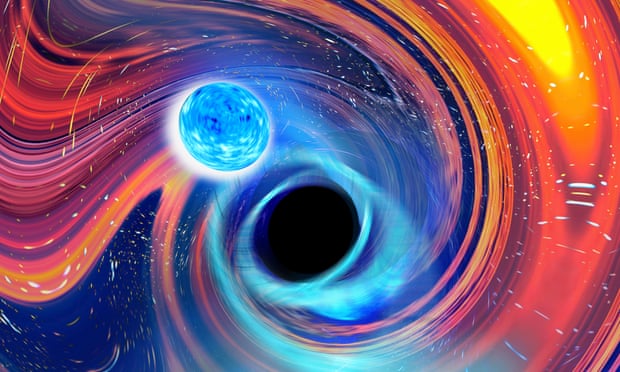There are moments when life as an astrophysicist is like hanging around at the bus stop. You wait ages for a cataclysmic cosmic event to send shock waves through the fabric of spacetime and then two come along at once.
Years after scientists began their search for quivers in spacetime anticipated by Albert Einstein, gravitational wave detectors in the US and Europe have detected the first signals from two neutron stars crashing into black holes hundreds of millions of light years away.
“We are talking about objects that have more mass than the sun that have been gobbled up,” said Dr Vivien Raymond at Cardiff University’s GravityExploration Institute. “We would like for the neutron stars to be ripped apart and shredded because then there’s a lot of opportunity for interesting physics, but we think these black holes were big enough that they swallowed the neutron stars whole.”
The first collision, called GW200105, was spotted in data recorded on 5 January 2020 by the US Laser Interferometer Gravitational-Wave Observatory (Ligo). Gravitational waves unleashed by the event suggest that a neutron star twice as massive as the sun fell into a black hole nine times more massive than the sun. Moving at the speed of light, these gravitational waves, which squeeze and stretch spacetime as they race across the universe, would have taken 900m years to reach Earth.
Ten days later, Ligo and the Virgo gravitational wave detector in Italy recorded a second distinct signal, named GW200115, that was produced when a neutron star 50% more massive than the sun crashed into a black hole six times more massive than the sun. The event was even more distant than the first at 1bn light years away. Details are published in The Astrophysical Journal Letters.
Black holes and neutrons stars are what is left behind when stars reach the end of their lives and collapse under their own gravity. In some cases they are born as a pair, in binary star systems where one star orbits another. Neutron stars are among the most exotic objects in the known universe. Measuring 20 miles wide they have crusts and crystalline cores. They are so dense that a teaspoon of neutron star weighs as much as Mount Everest.
Gravitational waves pass through Earth all the time, but the shudders in spacetime are too subtle to detect unless they are triggered by collisions between extremely massive objects. Scientists reported the first detection of gravitational waves from the collision of two black holes in 2016 and have since spotted waves from neutron star mergers. Recording gravitational waves from neutron stars hitting black holes marks another first.
“With these events, we’ve completed the picture of possible mergers amongst black holes and neutron stars,” said Chase Kimball, a graduate student at Northwestern University in Illinois. “That doesn’t mean that there are no new discoveries to be made with gravitational waves. There are plenty of expected gravitational wave sources out there that we’ve yet to detect, from continuous waves from rapidly rotating neutron stars to bursts from nearby supernovae, and I’m sure the universe can find ways to surprise us.”
The Guardian
More about: #Gravity #BlackHole
















































